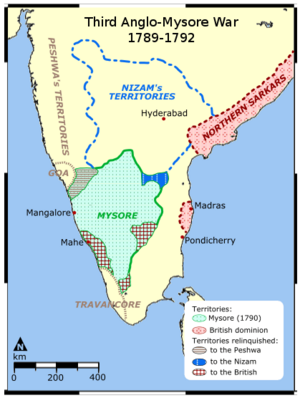Mysore (1789–1791) facts for kids
Quick facts for kids Third Anglo-Mysore War |
|||||||||
|---|---|---|---|---|---|---|---|---|---|
| Part of the Anglo-Mysore Wars | |||||||||
 A map of the war theatre |
|||||||||
|
|||||||||
| Belligerents | |||||||||
|
|
|
||||||||
| Commanders and leaders | |||||||||
The Third Anglo-Mysore War was a big conflict in South India that happened between 1789 and 1792. It was fought between the Mysore (led by Tipu Sultan) and a powerful group called the "Triple Alliance." This alliance included the East India Company (from Britain), the Maratha Empire, and Hyderabad. This war was a major part of the larger Anglo-Mysore Wars series.
Contents
Why the War Started
The war began when Tipu Sultan, the ruler of Mysore, attacked Travancore on December 29, 1789. Travancore was an ally of the British. This attack worried the rulers of Hyderabad and the Marathas. They decided to team up with the British. This new team was called the "Triple Alliance."
Key Events of the War
The Third Anglo-Mysore War lasted for about two years. It involved three main military campaigns.
First Campaign
At first, William Medows led the British forces. However, the British faced some challenges. They found it hard to defeat Tipu Sultan's army.
Cornwallis Takes Command
After the first campaign, Lord Cornwallis, who was the Governor General of British India, took charge of the British forces. He was a very experienced military leader.
Capturing Bangalore
Under Cornwallis's command, the British army made significant progress. They successfully captured the city of Bangalore on March 21, 1791. This was an important victory for the Triple Alliance.
Challenges at Seringapatam
After Bangalore, Cornwallis tried to capture Seringapatam. This was Tipu Sultan's capital city and a very strong fort. However, Tipu Sultan showed brilliant leadership. Heavy rains also made it difficult for the British. Because of these reasons, Cornwallis failed to capture Seringapatam at that time.
Fighting Continues
The fighting did not stop. Tipu Sultan's forces fought back. They managed to capture Coimbatore on November 3. Meanwhile, an army from Bombay came to help Cornwallis. They occupied a hill fort called Nandy Droog. This fort was about 50 kilometers (31 miles) north of Bangalore. It was important for keeping the supply lines open towards Seringapatam.
March to Seringapatam
Cornwallis and his allies continued their advance. They reached Seringapatam on February 5, 1792. The city was now surrounded by the Triple Alliance forces.
The Treaty of Seringapatam
Facing a complete defeat, Tipu Sultan decided to make peace. He signed a treaty in March 1792. This agreement was called the Treaty of Seringapatam.
Terms of the Treaty
Under the treaty, Tipu Sultan had to give up about half of his kingdom.
- A large part of the land went to the Nizam of Hyderabad.
- Another portion went to the Marathas.
- The British gained control of several important areas. These included Malabar and Coorg on the west coast. They also got Dindigul and nearby districts in the south. Finally, they received the Baramahal district in the east.
This treaty significantly reduced the power and size of the Kingdom of Mysore.

